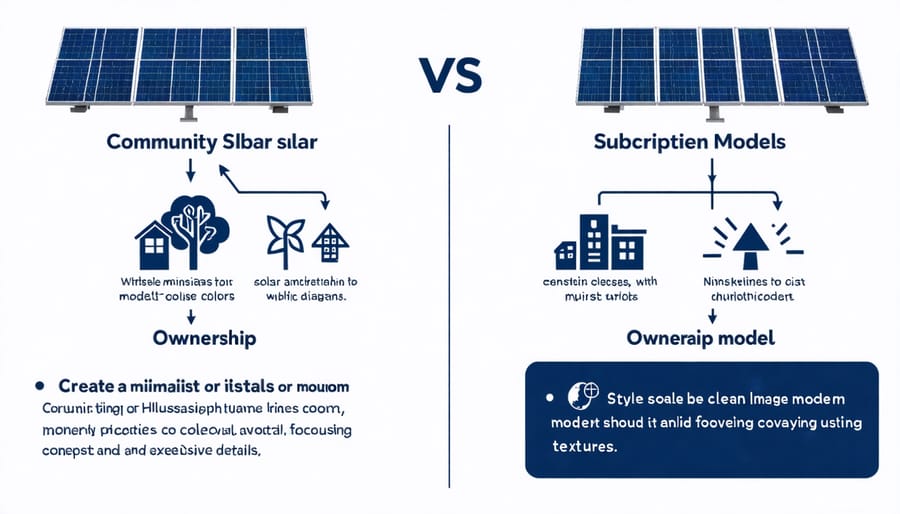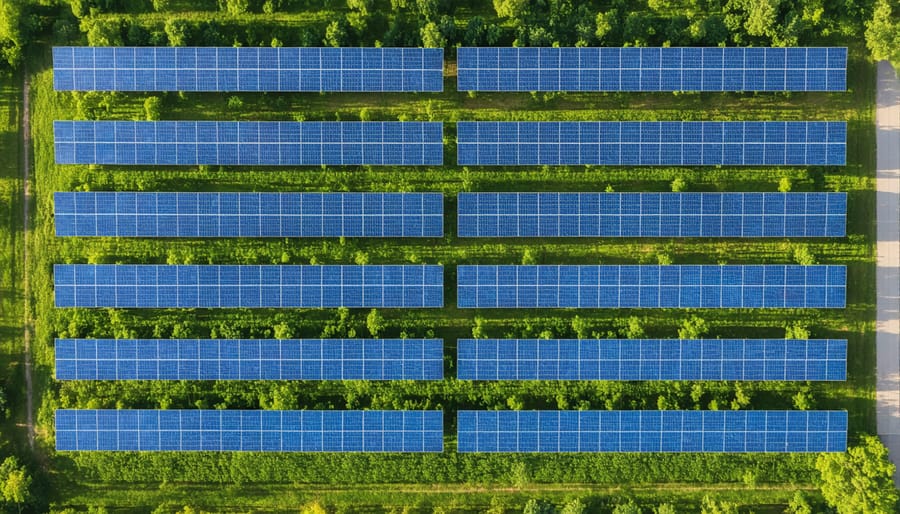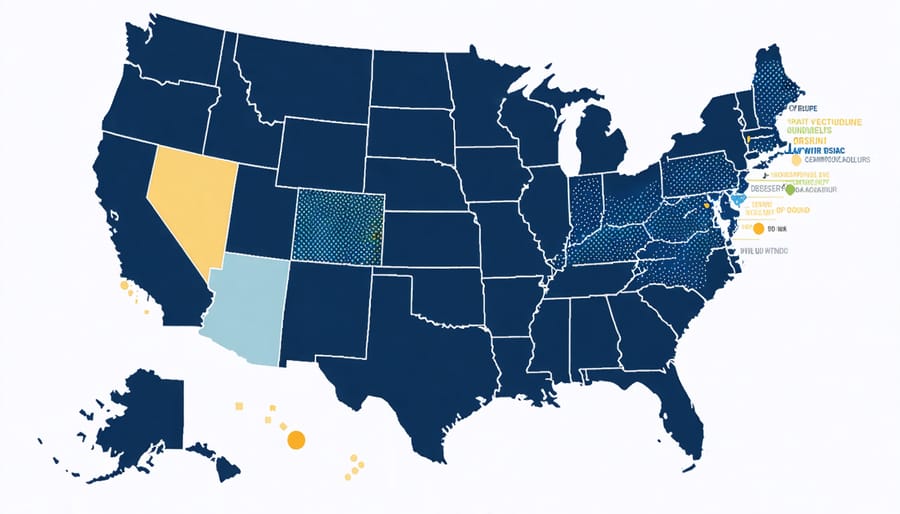Community solar programs are rapidly transforming local energy markets across the United States, enabling unprecedented access to renewable energy for businesses, households, and municipalities. With over 40 states now implementing various forms of shared solar initiatives, these programs have emerged as a critical solution for organizations seeking to reduce energy costs while advancing sustainability goals.
The landscape of state-specific community solar legislation varies significantly, from Massachusetts’ pioneering SMART program to Minnesota’s nation-leading 800+ megawatts of installed capacity. These differences in policy frameworks, incentive structures, and implementation models create distinct opportunities and considerations for stakeholders in each region.
Understanding these state-by-state variations is essential for businesses and community leaders looking to participate in or develop community solar projects. Success stories from states like New York, which has committed to powering 700,000 homes with community solar by 2025, demonstrate the substantial economic and environmental benefits available through well-designed programs.
This comprehensive analysis examines the current state of community solar across America, highlighting successful implementation strategies, regulatory frameworks, and opportunities for participation in each state’s unique program structure.
How Community Solar Programs Work
Subscription vs. Ownership Models
Community solar programs typically offer two primary participation models: subscription and ownership. Under the subscription model, participants pay a monthly fee to receive credits on their utility bills based on their allocated portion of the solar farm’s production. This approach requires minimal upfront investment and offers flexibility in terms of commitment length, making it particularly attractive for renters and businesses with shorter-term facility leases.
The ownership model allows participants to purchase a specific number of solar panels or a defined portion of the solar array. While this option typically requires a larger initial investment, it often yields higher long-term savings and may qualify for additional tax incentives. Ownership stakes can also be transferred or sold if participants relocate within the same utility service area.
Both models offer distinct advantages depending on participants’ financial goals and circumstances. Subscription models generally provide immediate savings with lower risk, while ownership models can deliver greater financial returns over time. Many states now require community solar programs to offer both options, ensuring broader accessibility across different income levels and investment capabilities.

Financial Benefits and Incentives
Community solar programs offer substantial financial benefits through various incentives and cost-saving mechanisms. Participants typically see 10-20% reduction in their electricity bills, with some programs delivering savings of up to 30% depending on state policies and program structure. These sustainable energy initiatives often require no upfront investment, eliminating the traditional barriers to solar adoption.
Subscribers benefit from net metering credits, which are applied directly to their utility bills based on their share of the solar project’s generation. Many states offer additional incentives, including Solar Renewable Energy Credits (SRECs), tax credits, and performance-based incentives that further enhance the financial returns.
Business participants can leverage these programs to meet sustainability goals while reducing operational costs. The predictable energy rates provided by community solar subscriptions also serve as an effective hedge against future utility rate increases, offering long-term price stability. Most programs feature flexible terms, allowing participants to transfer or cancel their subscription if they relocate, minimizing financial risk.
Leading States in Community Solar Development

Minnesota’s Solar Garden Success
Minnesota’s community solar garden program stands as one of the nation’s most successful implementations, generating over 800 megawatts of clean energy capacity since its inception in 2013. The program’s innovative subscriber-based model has attracted more than 22,000 participants, including homeowners, businesses, and public institutions, demonstrating the scalability of community solar initiatives.
The state’s program success stems from its well-structured policy framework, which enables multiple stakeholders to participate while reducing carbon emissions and creating local economic benefits. Xcel Energy, the state’s largest utility, has played a pivotal role by facilitating interconnection and managing subscriber billing through their Virtual Net Metering system.
Key achievements include:
– Average subscriber savings of 10% on electricity costs
– Creation of over 4,000 clean energy jobs
– Development of more than 300 operational solar gardens
– $2 billion in private investment in renewable energy infrastructure
The program’s success has particularly benefited commercial subscribers, who constitute approximately 87% of total subscription capacity. These businesses leverage community solar subscriptions to meet sustainability goals while maintaining predictable energy costs. Minnesota’s model has become a blueprint for other states, demonstrating how well-designed policies and utility cooperation can drive community solar adoption at scale.
Massachusetts SMART Program
Massachusetts’ Solar Massachusetts Renewable Target (SMART) Program represents one of the nation’s most comprehensive solar incentive frameworks. Launched in 2018, this Department of Energy Resources (DOER) initiative provides fixed-rate incentives for solar projects up to 5 megawatts (MW) in size, with additional compensation for projects incorporating energy storage systems.
The program operates on a declining block system, where incentive rates decrease as more solar capacity is installed. This structure encourages early adoption while maintaining long-term market sustainability. Participants receive base compensation rates determined by project size, location, and utility territory, with additional adders for specific project characteristics such as brownfield development or low-income community service.
For community solar developers, SMART offers particularly attractive incentives through its community shared solar provisions. Projects serving low-income customers receive higher compensation rates, promoting equitable access to solar benefits. The program has successfully driven significant solar deployment across Massachusetts, with over 2,500 MW of solar capacity approved since its inception.
Notable achievements include the development of dual-use agricultural solar installations and increased energy storage integration. The program’s success has prompted several modifications, including the expansion of overall program capacity from 1,600 MW to 3,200 MW in 2020, demonstrating Massachusetts’ commitment to renewable energy leadership.
Colorado’s Pioneer Programs
Colorado stands as a pioneer in community solar development, launching its first programs in 2010 through the Community Solar Gardens Act. This groundbreaking legislation established a framework that has since become a model for other states nationwide. By 2022, Colorado had installed over 150 megawatts of community solar capacity, serving approximately 25,000 subscribers across various demographics.
The state’s program success stems from its innovative subscriber model, which allows residents, businesses, and organizations to purchase or lease portions of centralized solar arrays. These arrays, typically ranging from 500 kilowatts to 5 megawatts, provide subscribers with credits on their utility bills proportional to their share of the project’s output.
Notable achievements include the Low-Income Community Solar Demonstration Project, which ensures at least 5% of each community solar garden serves low-income households. This initiative has helped reduce energy costs for over 3,000 low-income families while advancing environmental justice goals.
The program’s economic impact has been substantial, creating more than 1,000 jobs in solar installation, maintenance, and administration. Local municipalities have benefited from increased tax revenue, while subscribers typically save 10-15% on their electricity bills.
Recent policy updates have expanded program capacity limits and simplified the application process, positioning Colorado to double its community solar capacity by 2025. The state continues to refine its regulations to maximize accessibility and economic benefits while maintaining system reliability and grid integration.

Emerging State Programs
New York’s Community Solar Expansion
New York has emerged as a national leader in community solar development, with ambitious goals under the NY-Sun initiative to install 10 gigawatts of distributed solar capacity by 2030. The state’s robust incentive programs and supportive regulatory framework have catalyzed significant market growth, delivering community-wide sustainability benefits while reducing energy costs for participants.
The New York Public Service Commission’s recent policy updates have streamlined the development process, enabling faster project deployment and broader community participation. Current regulations allow subscribers to receive up to a 10% discount on their electricity bills, making the program particularly attractive to businesses and residential customers alike.
Notable developments include the expansion of project capacity limits and the introduction of the Expanded Solar For All program, which specifically targets low-to-moderate income households. As of 2023, New York hosts over 500 operational community solar projects, with hundreds more in various stages of development. This robust pipeline positions the state to achieve its clean energy objectives while creating thousands of local jobs and strengthening grid resilience.
Illinois Solar for All
Illinois Solar for All (ILSFA) stands as a pioneering equity-focused program that ensures low-income communities and environmental justice populations have access to the benefits of solar energy. Launched in 2017 as part of the Future Energy Jobs Act, the program offers significant incentives that can cover up to 100% of solar installation costs for eligible participants.
The program operates through three main channels: residential single-family solar, multi-family affordable housing solar, and community solar projects serving low-income communities. Qualifying households must have income at or below 80% of the Area Median Income (AMI), while participating organizations must demonstrate that they serve these communities.
ILSFA has achieved remarkable success, with over 50 MW of solar capacity installed across disadvantaged communities as of 2023. The program guarantees participants at least 50% savings on their energy bills through a combination of solar credits and reduced electricity rates. Additionally, ILSFA prioritizes job creation in target communities, requiring that approved vendors provide job training and employment opportunities to local residents.
Project developers must meet strict consumer protection requirements and maintain transparency in all customer communications, ensuring program integrity and participant trust.
New Jersey Community Solar Pilot
New Jersey’s Community Solar Pilot Program, launched in 2019, has demonstrated remarkable success in expanding solar access across the state. The program aims to provide clean energy benefits to approximately 45,000 households, with a particular focus on low- and moderate-income (LMI) communities. Under the pilot’s framework, subscribers can save between 10-15% on their electricity bills without installing solar panels on their properties.
The first year of the pilot program saw the approval of 45 projects with a combined capacity of 78 megawatts. These projects are expected to serve over 12,000 households, with 51% of the capacity reserved for LMI participants. The success of the initial phase prompted the New Jersey Board of Public Utilities to expand the program, approving an additional 105 megawatts of community solar capacity in 2021.
Notable features of New Jersey’s program include streamlined billing processes, guaranteed savings for subscribers, and flexible contract terms. The pilot’s success has positioned New Jersey as a leader in community solar development, with the state planning to transition from the pilot phase to a permanent program by 2024, potentially serving over 100,000 households statewide.
Implementation Challenges and Solutions
Regulatory Framework Variations
State regulatory frameworks for community solar programs vary significantly across the United States, reflecting diverse policy priorities and market conditions. Leading states like Minnesota and Massachusetts have established comprehensive guidelines that mandate utility participation and set clear compensation mechanisms for subscribers. These states typically employ Virtual Net Metering (VNM) systems, allowing participants to receive credits directly on their utility bills.
Several states have adopted different approaches to program capacity limits. New York’s framework permits projects up to 5 megawatts, while Colorado restricts individual installations to 2 megawatts. These variations significantly impact project viability and subscriber accessibility. Additionally, states differ in their subscriber requirements, with some mandating minimum percentages of low-income participation, while others focus on geographic proximity to installations.
Interconnection standards also show notable differences. States like Maryland and Illinois have streamlined their processes to expedite project development, while others maintain more complex approval procedures. Consumer protection measures vary as well, with some states requiring extensive disclosure statements and others implementing minimum savings guarantees for participants.
The regulatory landscape continues to evolve, with emerging programs in states like New Jersey and Rhode Island drawing from established frameworks while introducing innovative elements. These variations demonstrate the importance of tailoring community solar regulations to local market conditions while maintaining program integrity and consumer benefits.
Best Practices for Program Success
Successful state community solar programs consistently demonstrate several key practices that drive adoption and sustainability. Program transparency and clear communication channels between stakeholders emerge as fundamental elements, ensuring participants understand their roles, benefits, and obligations. States that implement standardized billing and credit allocation systems report higher participant satisfaction and easier program management.
Effective programs typically feature streamlined subscription processes, reasonable contract terms, and flexible participation options that accommodate diverse customer needs. Many successful initiatives incorporate innovative solar applications and smart grid technologies to maximize system efficiency and participant benefits.
States with thriving programs often maintain strong partnerships between utilities, developers, and local governments. These collaborations facilitate faster project approvals, reduced soft costs, and better community engagement. Regular program evaluation and adjustment based on participant feedback helps ensure long-term sustainability and growth.
Cost allocation transparency, consumer protection measures, and clear dispute resolution processes have proven essential for building trust and maintaining program integrity. Additionally, successful programs typically include provisions for low-income participation, ensuring broader community access and social equity.
Comprehensive monitoring and reporting systems help track program performance and demonstrate value to stakeholders. States that incorporate these elements while maintaining flexibility to adapt to changing market conditions and technological advances consistently achieve higher participation rates and program stability.

Community solar programs are poised for significant expansion across the United States, with projections indicating a potential market growth of 400% by 2027. This remarkable trajectory is driven by increasing state-level support, technological advancements, and growing consumer demand for sustainable energy solutions.
For businesses and communities interested in participating in community solar initiatives, the time to act is now. Start by researching your state’s specific programs and regulations, as policies and incentives vary significantly by region. Connect with local solar developers and utility companies to understand available opportunities and partnership possibilities. Consider forming coalitions with other businesses or community organizations to increase buying power and project viability.
Key action steps include:
– Conducting a thorough assessment of your energy needs and consumption patterns
– Evaluating available community solar programs in your area
– Reviewing subscription models and financial incentives
– Engaging with stakeholders to build support
– Consulting with legal and financial advisors to understand contractual obligations
The future of community solar looks promising, with new financing models, improved technology, and streamlined regulations making these programs increasingly accessible. As more states adopt supportive policies and utilities embrace distributed energy resources, community solar will continue to play a crucial role in America’s transition to renewable energy.
Success in this evolving landscape requires staying informed about policy changes, maintaining flexibility in program design, and focusing on long-term sustainability rather than short-term gains. By taking proactive steps today, organizations can position themselves to benefit from this growing sector while contributing to a more sustainable energy future.

